
🎣 Hooked by Passion: The Journey from Bait to Byte 🌊
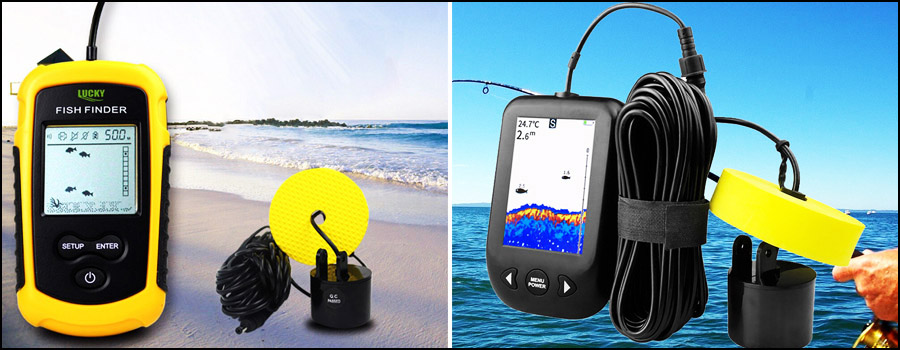
👋 There I was, knee-deep in water, feeling the cold rush of the river as it brushed against my legs. I held my breath, straining my eyes through the dawn’s early light. My heart pounded in sync with the soft swaying of the water. Then, suddenly, I felt it – the slightest pull at my line. A jolt of adrenaline rushed through me; I had a bite! 🐟 That’s the exact moment I fell irrevocably in love with fishing – the thrill of the catch, the unity with nature, and the tranquility of it all.
Fishing, as many of you passionate anglers out there know, is an art form. It’s a game of patience and intuition. But let’s face it, even the most skilled artists have their off days. Days where you cast your line time and time again, only to come up empty. The unpredictable nature of our aquatic adversaries has long been one of the primary challenges of fishing. 🚣♀️
However, as we stand in the 21st century, technology has started to seep into every corner of our lives – and fishing is no exception. In recent years, we’ve seen an exciting surge in technologically advanced tools designed to enhance our fishing experiences, making it more efficient and less reliant on guesswork. This is where the topic of our discussion enters the scene – the portable fish finder, a revolutionary tool that has changed the game in the fishing industry. 🎛️
🔶In essence, this nifty gadget has transformed fishing from a game of chance to a more predictable and rewarding experience. It’s like having your personal scout, diving beneath the surface, reporting back with a detailed analysis of what’s happening in the underwater world. The portable fish finder is not just a tool; it’s a window into the aquatic world, a game-changer in the truest sense. So, let’s dive deeper and learn more about this fantastic piece of technology. 🐠🌊🔍
🕰️ Reeling in the Past: Unspooling the History of Fish Finding 🎣
Long before the advent of technology-enhanced fishing, anglers relied on years of experience, intuition, and traditional methods for locating fish. This was no easy task and required keen observation and a profound understanding of aquatic life. 👀🐟
Anglers used to study water currents, bird movements, and natural structures such as reefs or underwater vegetation to predict the presence of fish. They’d note the time of day, the season, the water temperature, and the type of bait to increase their success rate. While these techniques worked to some degree, they were time-consuming, required extensive knowledge, and lacked precision. 😓⏳
As we moved into the 20th century, technology began to make waves in the fishing industry. The echo sounder, or depth finder, was one of the first significant breakthroughs. Introduced in the 1950s, this device used sonar technology to determine water depth and detect underwater objects – a huge leap forward from mere guesswork! 📟🌊
Fast-forward to the 21st century, and we’ve witnessed a revolution in fishing technology, with the portable fish finder being the crown jewel. These devices use advanced sonar and GPS technology to give a detailed view of the underwater world, right in the palm of your hand. From identifying fish and their depth to mapping the underwater topography, these gadgets offer an unprecedented level of detail and accuracy. 📱🐠
The progression from rudimentary observations to sophisticated devices like the portable fish finder is truly remarkable. These tools have not only made fishing more efficient and successful but also have opened up a whole new world of possibilities for anglers worldwide. 🌎🎣
🔶Stay tuned as we delve deeper into what a portable fish finder is and how it’s transforming the fishing experience in our next section! 😉👍
🧭 Navigating New Depths: The Dawn of the Portable Fish Finder 🐟
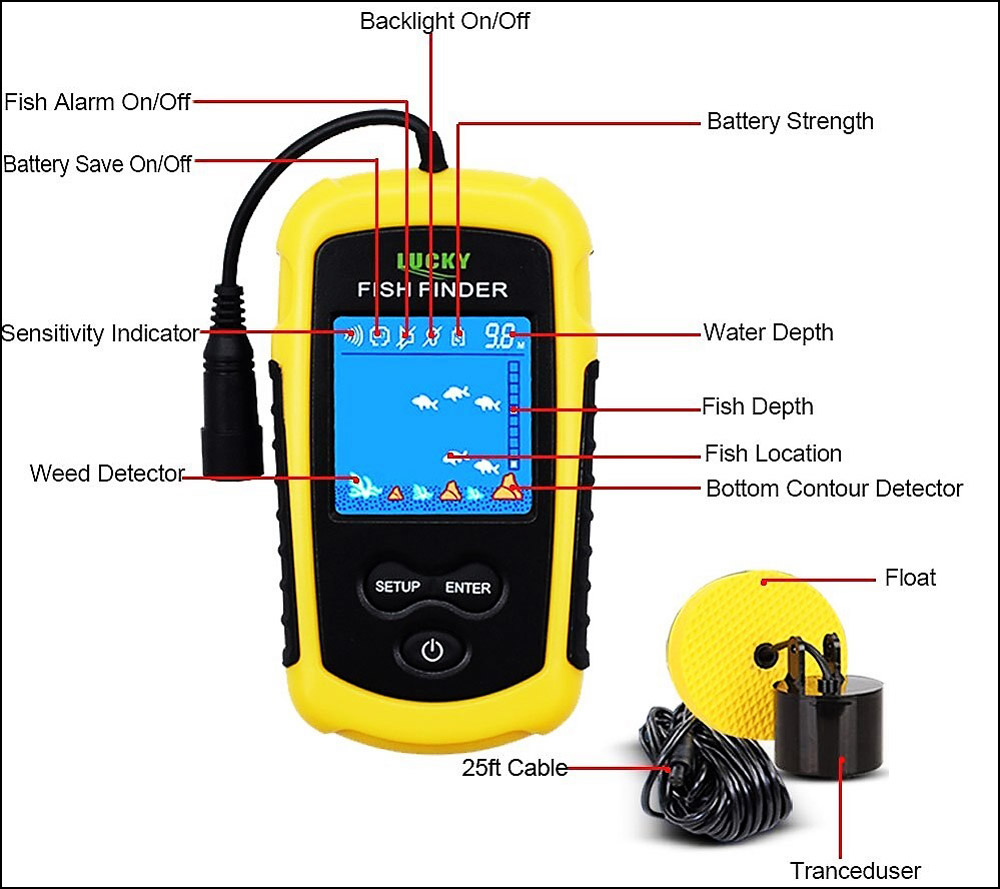
Ever wondered what’s beneath the water surface as you sit in your boat, waiting for a bite? Imagine if you had an underwater scout, reliably informing you of what lurks beneath. Say hello to the portable fish finder – your very own aquatic ally! 👋🎣
Simply put, a portable fish finder is a compact, handheld device that uses sonar technology to detect and display what’s underneath the water surface on an LCD screen. It’s like having underwater X-ray vision, providing a detailed picture of the aquatic world beneath your boat. From identifying schools of fish to mapping the contours of the lake bed, this gadget sees it all. 📱🔍🐠
Now, let’s delve into how this remarkable device works. The fish finder employs sonar (Sound Navigation and Ranging) technology, initially used by submarines in warfare and for research purposes. When you cast the transducer – the part of the fish finder that sends and receives signals – into the water, it sends out sound waves. When these waves hit an object, like a fish or the lake bed, they bounce back to the transducer. 🌊🔊
The time it takes for the sound waves to return informs the device of the depth at which the object is located. The returned waves or ‘echoes’ are then interpreted by the device’s software, which displays the underwater scene on the screen. Different objects are represented by different shapes, allowing you to distinguish between fish, vegetation, rocks, and more. 🐟🌿🪨
It’s like having your private submarine scanning the depths, giving you an edge in the age-old dance between angler and fish. So, whether you’re a seasoned pro or a beginner angler, the portable fish finder is your ticket to upping your fishing game! 🚀🎣
🔶Stay hooked as we uncover the benefits of using a portable fish finder in our next section. 😉👍
💪 Casting Away Doubts: The Undeniable Benefits of Portable Fish Finders 🎣
Fishing has long been a game of patience. But with the advent of the portable fish finder, anglers can now enhance their fishing experiences in numerous ways. Here are the top benefits of using this revolutionary tool: ⬇️
1️⃣ Efficiency: Save Time, Catch More 🕓🐟
The guessing game of “Are there any fish here?” is replaced with real-time, accurate data about fish locations. No more wasted time fishing in barren zones. With a portable fish finder, you’re guided directly to where the action is, increasing your chances of a successful catch. It’s like having a fast-forward button, getting you straight to the thrilling moment of reeling in a big one! 🚀🎣
2️⃣ Accuracy: Know Your Fish 🎯🐠
Ever cast your line hoping for a trout but ended up with a boot? Those days are over. Portable fish finders can differentiate between objects of different sizes and densities, allowing you to identify fish species and even estimate their size. Additionally, it can show you the depth at which fish are located, helping you adjust your bait and tackle accordingly for an optimal catch. With this tool, you’ll know what you’re aiming for and how to get it. 🔍
3️⃣ Convenience: Anytime, Anywhere 🌍🎒
With the “portable” in its name, it’s no surprise that these devices are designed for easy use and transportation. They’re compact, lightweight, and often come with user-friendly interfaces. Plus, they can be used in various environments, whether you’re fishing from a boat, a dock, or even ice fishing in winter. From seasoned pros to beginner anglers, this is a gadget that can be conveniently utilized by everyone. 🚣♂️🎣❄️
🔶In summary, a portable fish finder isn’t just an optional accessory; it’s an essential fishing companion that brings efficiency, accuracy, and convenience to your fishing trips. In our next section, we’ll help you choose the perfect portable fish finder to fit your needs. Stay tuned! 😉👍
TOP 10 Best Fish Finders Reviews
With a fish finder, you can find out in advance whether there’s any fish nearby at all, and not waste time in vain when there’s too little or none at all. It also allows you to find out how deep the pond is, what’s the relief of its bottom – for fishing, this is also useful information. Next, we’ll analyze the main nuances associated with the choice of a fish founder, and determine the 10 best fish finders from the models that are currently on sale. Let’s get straight into our article!
There are many devices for detecting fish in water bodies on the market today. But there are very few high-quality fish finders, and it’s very easy to confuse the fish finder with another fishing electronic device or stumble upon a cheap fake. That’s why we’ve collected for you the 10 best fish finders in our opinion, affordable and high-quality. Let’s look at them!
#1 Garmin Striker 4 Traditional Transducer Fishfinder
The fish finder from Garmin has good features for its cost and weight of just 300 grams. The transducer is powerful enough to search for fish and determine its size in any weather, there’s also a temperature sensor. The screen is available in 3.5, 5 or 7 inches. The display allows you to see everything well, there’ll be no flare in the sun.
A noteworthy model is a software for creating underwater maps of a large area – the area can reach 89 kilometers. Previously, such functionality was present only in more expensive devices from this manufacturer. There’s a GPS module in this fish finder. Mains power 12 V. Transom mount, fasteners included. The manufacturer gives a two-year warranty. In addition to the standard pack, you can order a kit with an extra battery, a protective case, and various mounts.
#2 Lucky Handheld Fish Finder
This model is notable for its low cost, but with a sufficient set of functions; moreover, it’s very convenient to use. In winter, you can look for fish under the ice with the fish finder at temperatures up to -20 degrees. The dimensions are compact, the device can be easily carried in the inner pocket of the jacket, which allows extending the battery life. If you lower the fish finder sensor underwater, the range will be up to one hundred meters.
When fishing on a small river, you can see the entire width of the channel and instantly move from one place to another – where the fish is currently located. It can be installed onboard boats using a special mount. Also, the kit comes with a cable, the length of which is almost 8 meters, due to which the device can be used even when fishing from the shore. The fish finder gives a high-quality picture, which will also allow you to determine the structure and topography of the bottom, to find out if there are snags or silt, where tackle can get stuck.
The emitter frequency is 200 kHz. The display has a backlight function that can be turned off. The accuracy of the device is 10 cm, which is quite enough when fishing. The energy of 4 AAA batteries is spent quite economically. Since the device works close to water, it’s equipped with a waterproof cover. The screen diagonal is 4×4 cm. It is allowed to use the equipment at temperatures from -20 to +70 degrees.
🎦Video YouTube: Lucky Fish Finder Unboxing, Quick Look & Test
#3 Garmin Striker 4CV Fish Finder
Garmin Striker 4 CV Fish Finder allows you to create catching area maps for anglers. The model is equipped with a built-in GPS module, transducer, and software. The device is capable of creating maps for a large water area (up to 8 thousand square meters) with isobaths through 30 cm. On a bright display with a diagonal of 4.3 inches, the picture remains clear even in sunny weather.
The device interface is intuitive even for inexperienced users. Experts note the advanced Garmin CHIRP technology, it perfectly complements the work of ClearVu sonar. As a result, the fisherman gets an almost photographic picture of the underwater world. At the same time, goals are clearly identified and shared. The presence of such a fish finder will be the key to safe navigation in vast areas where coasts aren’t visible. The GPS receiver will help not only determine the route but also accurately determine the speed of the boat.
#4 Garmin 78S Marine Fish Finder
An excellent portable fish finder with a transducer and a 3-axis built-in compass that provides good parameters: the power of the fish finder is 1,600 W, the depth at which scanning is possible is up to 487 meters.
Even taking into account that these parameters can be achieved only under ideal conditions, and in reality, the indicators are usually lower, they’re still superior to many similar devices. Besides, the transducer can be replaced by a more powerful one from the same manufacturer. It’s powered by two AA batteries. also has a large amount of internal memory, which allows you to project fairly large-scale maps.
#5 Ricank Portable Fish Finder
Although this model is not well-known to users, unlike the products of other manufacturers, it deserves attention due to the high-quality material, excellent reliability, and extended functionality of the device. The beam viewing angle is 45 degrees, which allows it to work within a radius of 100 meters. The display here is a liquid crystal, its diagonal is 2 inches, the resolution is quite large, so the image quality is quite high.
The screen has a fairly bright backlight with which you can use such a device even in the dark. The overall dimensions are compact, the body is made of reliable plastic, which protects the product from various kinds of mechanical influences, water, and dust penetration.
The range of operating temperatures is quite wide – from -20 to +70 degrees. The fish finder has a sound notification system, it’s powered by 4 AAA batteries, they can work 6-7 hours in the energy-saving mode. The transmitter emitter is attached to the housing with a cable.
#6 Venterior VT-FF001 Portable Fish Finder
The low-cost and compact fish-finder Venterior VT-FF001 is an excellent option for fishing at shallow depths. But the power of the emitter is enough to penetrate a depth of up to 70 m. The device can be used in the summer, and in winter the device’s performance will suffer.
It’s equipped with a robust construction with a bright screen. The device works from 4 elements of type AAA. The model has many useful options, for example, the display shows the depth of water, the presence of fish in the form of familiar icons. The display has an anti-reflective coating that allows you to clearly see the picture even in bright sunshine.
Professional anglers attribute the strengths of the Venterior fish finder to an affordable price, accurate determination of the bottom relief in shallow waters, a robust body, and a contrast monitor. The disadvantages of the device are a weak wire, which is quickly rubbed against sharp edges, unstable to the severe frost of the battery.
#7 Deeper Pro+ Smart Fish Finder
This design is definitely among the best fish finders designed for fishing from a boat and shore. The principle of operation of this device is quite simple – this design can be tied to a fishing line or cord and lowered into the water, and the picture will be transmitted to a smartphone. This product doesn’t have a screen, and it’s mandatory to have a smartphone; accordingly, not only the battery of the product itself but also the battery of the mobile phone will be discharged.
For fishing from a boat, this design is suitable if there’s an active movement in the pond. The kit includes a mount for the fish finder itself, but the mount for the smartphone (if you need it) will need to be purchased independently. The range of contact with the smartphone is up to 40 meters, and in many respects, that’ll depend on the power of the smartphone itself. This model has a very compact size, so it’s very easy to carry.
Most fishermen note the versatility of the product since it can be used both in winter and for fishing from the shore. The bottom relief defines simply excellently, also shows silted areas, the presence of snags and other features of the reservoir, for which the bait or hook can catch.
The fish finder has two radiation sources – one at 15 degrees with a frequency of 290 kHz, the second has a wider viewing angle of 55 degrees, and a frequency of 90 kHz. The built-in rechargeable battery is capable of working without interruption for up to 7 hours.
The body is absolutely waterproof, withstands even immersion to a considerable depth. The display isn’t provided here, the screen is a mobile phone with Bluetooth function. Also, the device allows you to measure the temperature of the water, and when fishing from a boat you can also create a depth map.
#8 Rcank Portable Wireless Fish Finder
Simplicity and reliability are the main parameters of this fish finder. The Rcank model was included in our rating of the best fish finders for its compactness and accuracy. The device copes with the relief, determining the depth, temperature, and location of the fish. All parts can withstand low temperatures (up to -20 ° C), and the working depth reaches 36 m. The wireless range is up to 200 m. The manufacturer recommends the use of a fish finder both in freshwater bodies and in saltwater. The portable device is powered by a battery that is charged via USB. The fish finder operates for up to 10 hours when fully charged.
#9 ReelSonar Wireless Bluetooth Fish Finder
The ReeISonar is a wireless fish finder that works in tandem with a tablet or smartphone. It’s enough to install a free app of the same name on a mobile device to begin studying the relief of the water area. The fish finder weighs 11 ounces, so the device must be equipped with a durable fishing line. The bobber itself transmits information through the Bluetooth connection, the range reaches 90 m. The device can work in a wide range of temperatures (-20 … + 40 ° C) and depths (2 … 135ft).
In addition to determining the depth, the device shows the angler the water temperature, the nature and density of the relief, the presence of fish. The manufacturer provided for the adjustment of sensitivity, the builder of maps, the adjustment of the blind zone. The fish finder is equipped with a battery, which is fully charged for 7 hours of continuous operation. It’s possible to fully restore the battery capacity within 2.5 hours.
#10 Garmin 010-01870-00 Striker Plus 4 Dual-Beam Transducer
The Garmin STRIKER PLUS 4 fish-finder can give the fisherman complete information about the underwater environment. Thanks to the bright display and high detail, the picture is clear and understandable. The device has a wide scope, fishermen use it when fishing from inflatable boats and metal vessels, in fresh and saltwater. Garmin works from the onboard network of the boat (12 V), which allows you not to think about discharging batteries at a crucial moment.
The research of the underwater environment occurs using a two-beam emitter. The built-in transducer is easily attached to the transom of the boat. Thanks to the GPS module, it’s possible to remember promising points, saving time when searching for a catchy place. Fishermen use the Garmin STRIKER PLUS 4 fish finder in a variety of conditions. The device clearly shows the bottom topography and the presence of fish in a selected section of the reservoir. The disadvantages include raw firmware.
🧐 Reeling in the Right Gear: Choosing Your Perfect Portable Fish Finder 🎣
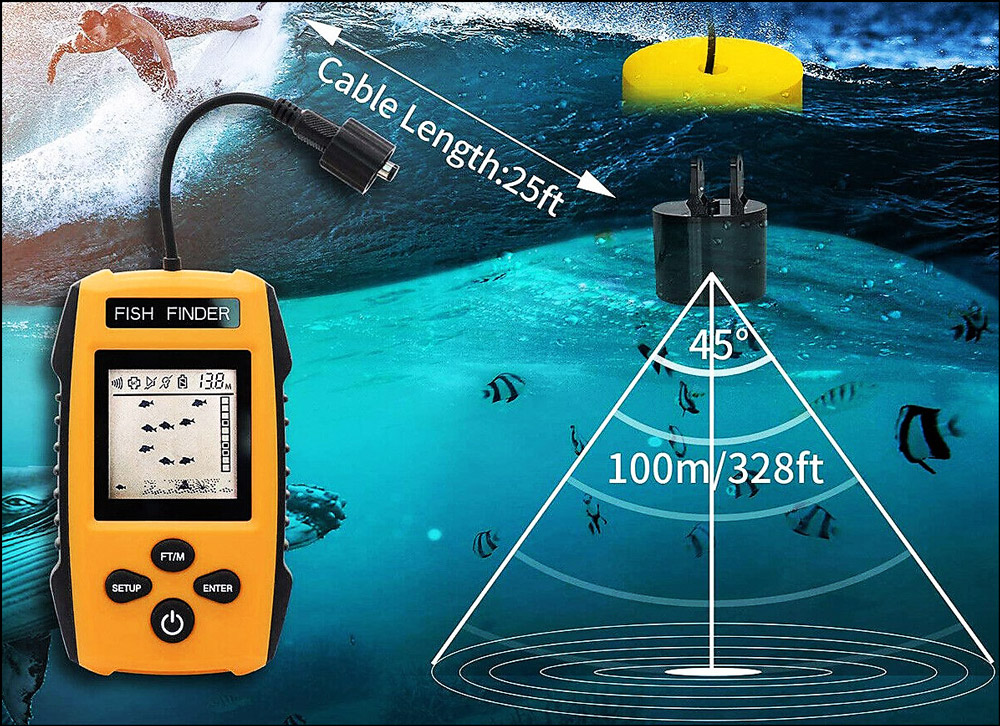
Just like selecting the right rod, reel, or bait, choosing a portable fish finder requires some thought. With a plethora of models available, it can be tricky to know which one best fits your needs. To help you navigate these waters, here are a few key factors to consider: 📝
1️⃣ Screen Resolution 📱🔍
The clarity of your fish finder’s display directly impacts your ability to interpret the underwater world. Higher screen resolution translates to more details and a clearer picture. Aim for a fish finder with a resolution of 240 x 160 pixels as a minimum.
2️⃣ Power 🔋🏎️
The power of a fish finder is measured in wattage (W). More wattage means faster display of readings. If you typically fish in shallow waters, lower power may suffice. But for deeper waters, you’ll want a high-powered device.
3️⃣ Frequency 📡🐠
Fish finders usually operate at frequencies like 50, 83, 192, and 200 kHz. Higher frequencies (192 and 200 kHz) work best in shallow waters, while lower frequencies (50, 83 kHz) are suited for deeper sea fishing.
4️⃣ Transducer 🔊🎯
The transducer is the heart of the fish finder, sending out and receiving the sonar waves. Pay attention to the cone angle – a wider angle covers more area but provides less detail. A dual-beam transducer can be a good compromise, offering both broad coverage and detailed view.
5️⃣ GPS Functionality 🛰️🗺️
Having a fish finder with a built-in GPS can be a game-changer. It helps you mark productive spots, navigate waters, and plot courses, making your fishing expeditions more efficient.
Through my personal fishing journeys, I’ve had the chance to try a few different models. The Garmin Striker 4 stood out with its high sensitivity GPS and crystal-clear imagery. For those on a budget, the LUCKY Handheld Fish Finder provides excellent value for money, with its easy-to-read display and versatile settings.
🔶Choosing the right portable fish finder is a personal journey. What works best for one angler might not suit another. Consider your specific needs, preferences, and budget, and you’re sure to reel in the perfect device for you. In our next section, we’ll share some tips on how to maximize the benefits of your new gadget. Stay tuned! 😉👍
How to Use the Fish Finder Effectively to Catch More Fish
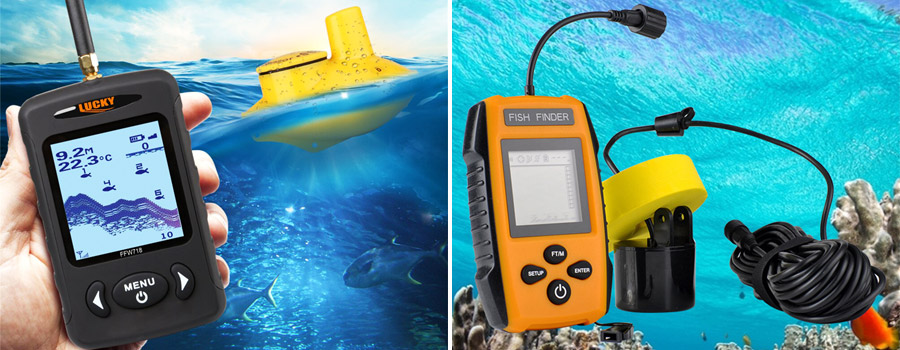
To know where more or less fish is located, you need to not only see but also be able to read and understand the readings of the fish finder. Take a couple of minutes to read the manual and you can effectively detect the presence of fish, determine its size, bottom topography, its type, and density.
Principle of Operation
Firstly, scanning is performed by a scanning beam. What does it mean? The size of the scanned area depends on the width of the angle of the scanning beam. The wide-angle is 40°–60°, i.e. the area it covers is quite large. The narrow beam has a width of 10°–20°. When interpreting the data displayed by a fish finder, it’s important to know which beam is scanning (wide or narrow). Secondly, it’s important to remember that the fish finder continuously transmits and receives data, while the image on the screen moves all the time. Current scan data is displayed on the right; old data moves to the left as new data is received.
Thus, when studying the data on the screen, it’s important to remember 2 things:
- Know which beam the scan was performed: wide or narrow.
- Continuous image movement doesn’t mean that the fish finder is moving.
Fish Identification
Fishfinders can show fish in two ways – icons or arcs. Fish icons are a useful tool in the first stages of using the fish finder: the device interprets the received data about the objects and tries to determine if it’s a fish or not. This takes into account factors such as the size of the object and the strength of the returned fish finder signal. Different fish swim at different speeds and in different directions relative to the beam of signals emitted by a fish finder. This means that their indicators can’t always be read in the same way. Besides, some underwater objects or algae can sometimes give indicators similar to fish.
Therefore, you need to learn how to independently interpret the data received by the fish finder to use it as efficiently as possible. Decide on an important step and turn off the fish icons – as a reward you’ll get more accurate indicators of the location of the fish. An additional bonus for determination will be new useful knowledge and improved skills. If the fish icons are disabled, how can I detect if there are fish on the fish finder data screen? Need to look for fish arcs. The fish will be displayed on the screen in the form of arcs. It’s important to remember that arcs can vary in size (length and width) and may be incomplete – half arcs should also be paid attention to.
Fish Arc Length
When interpreting the indicators of a fish finder, fishermen are most often mistaken in accepting long arcs as large fish. This is not true. On the screen displayed by the fish finder, the length of the arc means time. For example, imagine that the fish finder is stationary in the water. If the same motionless fish is under it, how will it be displayed on the screen? You’ll see one continuous line. This doesn’t mean that you have stumbled upon a huge blue whale in the lake. This means that under your fish-finder there is a still fish, the size of which can be very modest.
Imagine another situation: your fish finder is motionless, but 2 fish, large and small, swim in the area covered by its beam. Big fish swim through the scanning beam very quickly, small fish – slowly. Which one will be displayed with a long arc on your screen? The correct answer is a small fish. Because a slowly moving object leaves a longer track than a fast-moving object, regardless of its size.
Fish Arc Width
So, the length of the fish arc can’t be used to judge the size of the fish. It’s much more correct to pay attention to the width of the fish arc. Rule of interpretation of fish arcs: think vertically, not horizontally. Even if the fish arc is short but wide, it means that the signal is reflected from a large fish.
🎯Mastering the Depths: Tips & Tricks for Using Your Portable Fish Finder 🎣

You’ve got your hands on a portable fish finder. Now what? Understanding how to use this powerful tool effectively can be the difference between a fishing trip and a successful fishing trip. Here are some insider tips to ensure you make the most of your fish finder:
1️⃣ Get Familiar with Your Device 📖🤓
Every fish finder comes with its unique features and functions. Spend some time getting to know your device. Read the manual, understand the settings, and experiment in different conditions. The more familiar you are with the device, the more effectively you can use it.
2️⃣ Optimize the Sensitivity Setting 🎛️🔬
The sensitivity setting determines how much detail is displayed. Higher sensitivity shows more detail but may clutter the screen with too much information. Start with a medium setting and adjust as needed based on the clarity of the display.
3️⃣ Use Fish ID with Caution 🐟🧐
Many fish finders offer a Fish ID feature that shows fish icons instead of arches. While this can be helpful for beginners, remember that it’s not foolproof. It could mistake debris or vegetation for fish. As you get more experienced, try interpreting the raw sonar data for more accurate readings.
4️⃣ Don’t Ignore the Bottom 🌊🔎
The bottom contour can tell you a lot about where fish might be hiding. Look for sudden changes in depth, underwater structures, or vegetation – these are often favorite spots for fish.
5️⃣ Keep It Clean and Safe 🧽🔒
Keep the transducer clean for optimal performance. Also, remember to remove it before you dock or trailer your boat to prevent damage.
I’ve had my fair share of experiences with fish finders – from frustrating early attempts to gratifying catches thanks to the device. My parting advice is to practice and be patient. It takes time to interpret the data correctly, but once you get the hang of it, your fishing game will be transformed forever.
🔶Up next, we’ll wrap up our comprehensive guide to portable fish finders. Don’t go away just yet! 😉👍
Definition of Different Types of Underwater Terrain

Fishfinders are an ideal tool for measuring depth, determining the topography of the bottom, and other underwater characteristics. Sometimes this information means more than direct fish detection. Let’s learn how to interpret the underwater characteristics that your fish finder displays.
First, you need to remember two things:
- The fish finder scans continuously, so the image on the data screen will move, even if the fish finder doesn’t move. If the fish finder is stationary, the bottom image will be flat, but not always. To get an accurate image of the bottom topography, the fish finder needs to move slowly and smoothly.
- The depth scale on the right side of the screen allows you to determine the depth of any found object. Depth indicators in the upper right corner of the screen display the depth of the bottom under the fish finder at a given time – keep in mind that it may not coincide with the depth of the objects that you just scanned, especially if it was a hole or elevation.
These are very useful functions when catching many types of fish, and most importantly – they are always before your eyes when using a fish finder. As you move the sounder, you’ll see changes in the bottom topography – don’t forget to watch the depth gauge to track the dynamics of increasing or decreasing depth.
Use 3 tips that’ll help improve the accuracy of indicators when searching for such objects:
- Having found the hole, switch from a wide scanning beam to a narrow one, and scan this area again. That’ll help to obtain a more accurate image of the relief changes and to avoid blind spots during scanning.
- Instead of scanning, you can use the function of creating depth maps. These maps also show pits and depth changes and help you easily return to the best fishing spots.
- If you’re fishing in large areas (for example, from a kayak), set up a depth gauge that warns you of falling into a given depth range. So you can navigate in shallow water without the need to constantly monitor the fish finder, and when you hear a signal – reduce speed and check the displayed data.
These functions will also come in handy when catching many species of fish, especially predators that hide in depressions, waiting for prey. It’s important to pay attention to the color of displayed objects to identify flooded branches and logs. The frequency of the signal reflected from them will be different, so the fish finder will show them a different color from the bottom (otherwise such an object will look like a tuber)
Vegetation And Algae
Sometimes it’s important to identify areas with vegetation or algae to fish there or to get around them. Such places will also be highlighted, as well as flooded branches and logs. Algae and vegetation are displayed by vertical lines, and the signal from them will be more intermittent compared to logs.
Recesses
In some cases, as when fishing for carp, small indentations are ideal targets. Very often, such recesses are created by the fish themselves. They’re easy to detect with a fish finder – you just need to look for small v-shaped recesses in the topography of the bottom during movement.
Hills
The hills are more sloping compared to the recesses, but they’re identified equally easily. Maintain the same speed while moving the fish finder to get accurate slope indicators. In this case, you should use a narrow scanning beam to obtain the most accurate information and display all the shallows and mounds that may go unnoticed when scanning with a wide beam.
Other Underwater Objects
What can be hidden underwater? Sometimes unexpected objects can be displayed on the screen – for example, a fisherman in France, using a fish finder, found a car at the bottom of a lake. Not every object can be easily recognized, but its shape and the strength of the reflected fish finder signal help to do this. However, for all the usefulness of the function to detect strange underwater objects, the fish finder has a more practical task – to determine how hard or soft the bottom is.
The Use of a Fish Finder to Assess the Type and Density of the Bottom
Regardless of the type of fish you catch, information on the density and uniformity of the bottom of the reservoir is of key importance for good biting and successful fishing. To determine how hard or soft the bottom displayed on the screen is, there are 3 factors to consider: the color of the bottom, the thickness of the bottom line, and the presence of a second reflection of the signal.
The Color
The fish finder signals reflected from the hard and soft bottom are notable for their intensity. On the fish finder data screen, this difference is displayed in color. When using the standard color palette on the data screen, the color changes from dull brown (the softest surface) to bright orange (the hardest surface).
The Second Reflection
A solid bottom will reflect powerful signals that can sometimes come back and beat off from it again. On the screen, it’ll look like a second reflected signal passing under the bottom line parallel to it. This is an additional indicator confirming the hardness of the bottom.
Thickness
The thickness of the bottom line is another important indicator for determining its density. The rule is simple – the thicker the line, the harder the bottom. But be careful: the thickness of this line may be affected by the sensitivity of the fish finder. Some fish finders allow you to adjust the sensitivity when displaying data. If the sensitivity is increased to 100%, the bottom line may seem thicker, with a decrease to 10% the line may be thinner. Practice sensitivity settings and evaluate how much the thickness of the bottom line depends on them.
❓🤔 Frequently Asked Questions: Portable Fish Finder 🎣
🎣 The Last Cast: Wrapping Up the Wonders of Portable Fish Finders 🏆
Fishfinders are incredibly useful devices, and the better you learn how to interpret their indicators, the more effective your fishing will be. The main stage in teaching fishing skills is the transition from trial and error to knowledge-based practice. Perhaps you regularly fish in a certain place in a certain way – but do you know why in this place in this way? A fish finder will help you understand the reasons for both failure and success. And when you understand the reasons for success, it’ll be easier for you to repeat it.
As we reel in our deep dive into the world of portable fish finders, it’s clear that this innovative tool is revolutionizing fishing as we know it. From offering unmatched efficiency by guiding us directly to the fish 🎯, to providing detailed insights into the underwater world 🌊, to offering unmatched convenience, this compact device proves to be an angler’s best friend. 🙌
Through my personal journey, the portable fish finder has been a game-changer. It’s transformed countless hours of guesswork and waiting into thrilling moments of reeling in the big one. 🐟🏆 It’s brought a touch of science to an age-old art, enhancing the experience while respecting the tradition. 🧪🖼️
In today’s world, embracing technology can mean the difference between a good day of fishing and a great one. And who wouldn’t want more great days on the water? 🌞🚣♂️
So, whether you’re a seasoned angler or just starting out, I encourage you to dive into the tech wave and give portable fish finders a try. With a bit of practice, you’ll be navigating these devices like a pro and fishing like you’ve never fished before. Remember, the fish aren’t going to find themselves! 🐠🔍
🔶Stay hooked, and let’s celebrate the love of fishing, together and technologically advanced! 🎣🌐🥳🎣
Tags: #best portable fish finder / #best portable fish finder for kayak / #best portable fish finder for shore fishing / #best fish finder / #what is the best portable fish finder

I live in Tenerife (Canary Islands) for the last 10+ years and share my daily fishing experiences on my website. Many years of personal experience as a fisherman and the vast experience of my friends allow me to write professionally on any fishing topics (from choosing a flashlight and equipment to deep-sea fishing).
All of my advice is based on practical real-world experience and will be useful to both novice anglers and professionals. Read more about the author.
Affiliate Disclosure: FishReeler.org sometimes gets paid for listings, through sponsors or affiliate programs like Amazon, Ebay, Cabelas, Bass Pro Shop, Shimano, Daiwa, Rapala, Renn, Okuma, KastKing, etс. Clicking a link helps keep FishReeler.org free, at no extra cost to you!
About the author: Each article is verified by the fishing expert Sergio Smirnoff. The articles are written by professional and amateur fishermen with 20+ years of fishing experience.
Note: The views and opinions expressed in this article are those of the authors and do not necessarily reflect the official policy or position of any agency. The articles are for informational purposes only, share your opinions in the comments and join the fishing discussions, let's share our fishing experiences together!

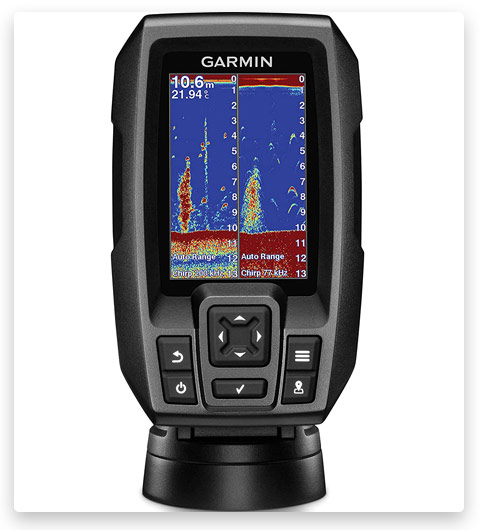
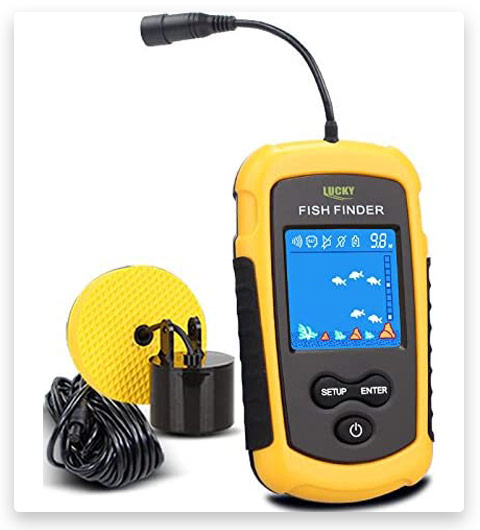
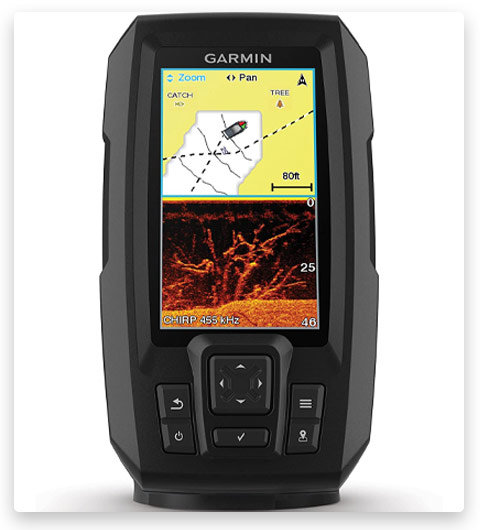
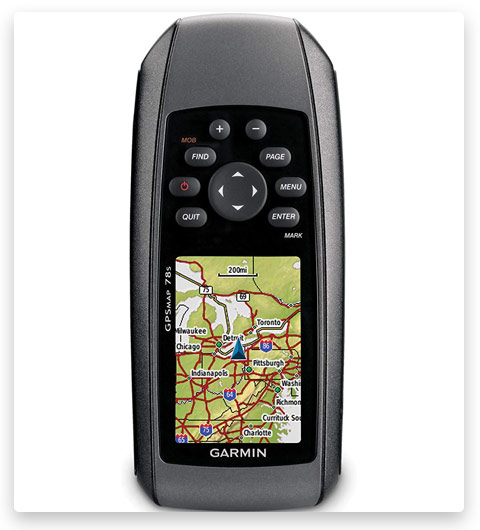
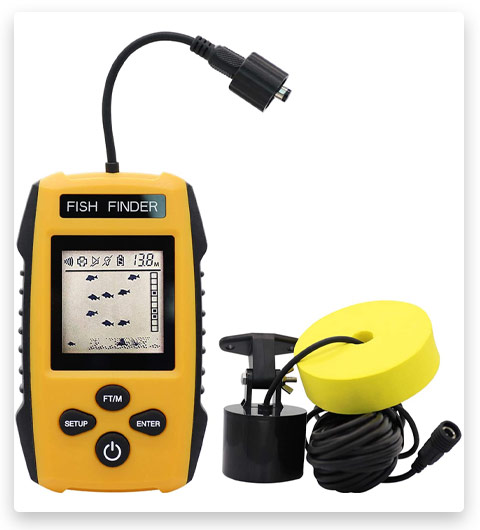
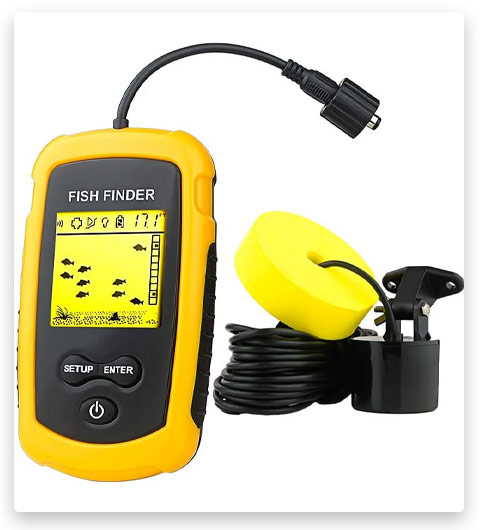
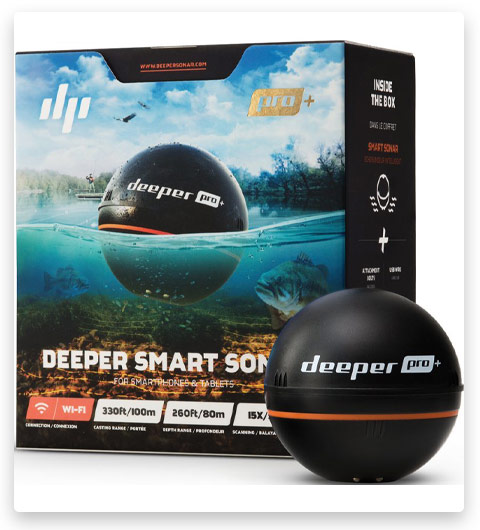
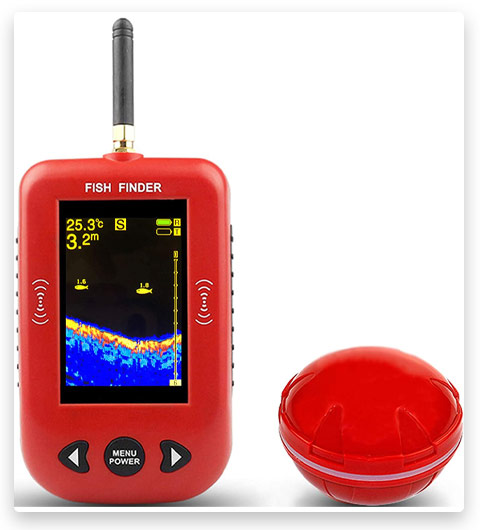
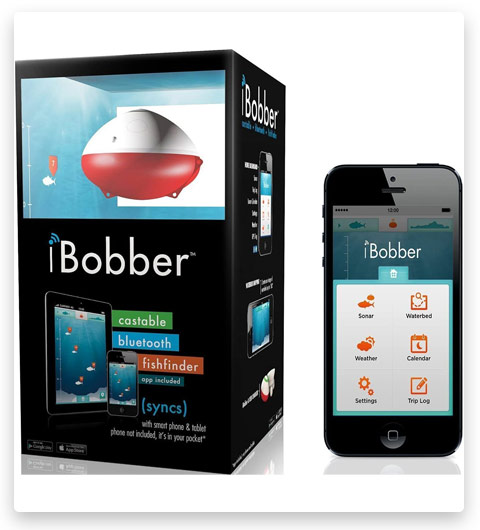

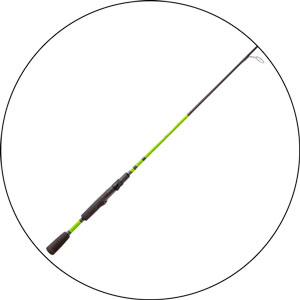
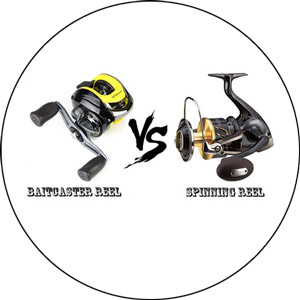
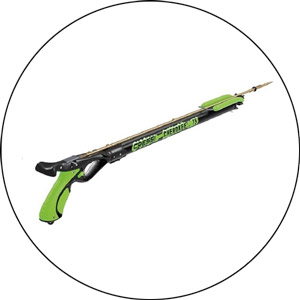

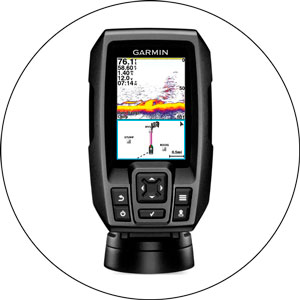
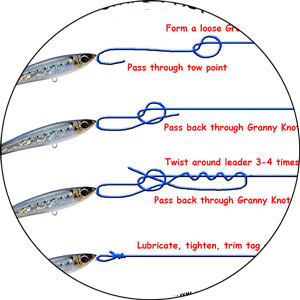
The portable fish finder reviewed in this article seems like a great option for anglers who are looking for a compact and easy-to-use device.
The ability to connect to a smartphone or tablet is a convenient feature that allows for easy navigation and data storage.
The high-resolution display and advanced sonar technology make for accurate and detailed readings of underwater structures and fish.
This Garmin Striker 4 with Transducer GPS Fishfinder is a game changer for any angler. Its compact design makes it easy to take with you on the go, while still providing accurate and reliable fish detection. The color display is also a great feature, making it easy to read and interpret the data.
I love the convenience of this Venterior Handheld Fish Finder. It’s small enough to fit in my tackle box, but still provides all the information I need to find fish. The battery life is also impressive, lasting a full day on a single charge.
The portability of this fish finder makes it perfect for kayak fishing. It’s lightweight and easy to mount, allowing me to focus on fishing rather than fumbling with equipment. The depth and fish detection capabilities are also top-notch.
I found this LUCKY Wired Fish Finder Sonar Sensor Transducer Water Depth Finder to be very useful on my fishing trips. It was easy to use, and the readings were accurate. The color display made it easy to see the fish and the bottom contours. I highly recommend it to any angler.
I purchased this RICANK Portable Fish Finder with Hard Travel EVA Case for my ice fishing trips. It worked well and helped me find fish quickly. The compact design made it easy to take out on the ice and the color display made it easy to read in the bright sunlight.
Hello, I am in search of a portable fish finder recommendation. My father is an avid trout fisherman who frequently fishes in the reservoirs. As motorized boats are not permitted, he uses a row boat which is anchored to a tree. I am looking for a portable fish finder that will be suitable for his fishing method and would greatly appreciate any suggestions from individuals who have experience using one. Thank you in advance for your help.
The choice is yours. I recommend my first product to everyone. Proven. I give its benefits and recommend it. The Garmin Striker 4 is a portable fish finder that offers a range of benefits for anglers. Some of the key benefits include:
Based on its features and capabilities, I would recommend the Garmin Striker 4 for anglers who are looking for an affordable, easy to use, portable fish finder that provides accurate fish detection and GPS/mapping capabilities. It’s suitable for freshwater fishing and it’s a great option for those who are just getting into fish finding technology, or for experienced anglers who are looking for a dependable device that won’t break the bank.
I have been using the Garmin Striker 4 and overall I am satisfied with the performance of the unit. However, I encountered an issue with the transducer mount that came with the device. It was designed for mounting on a trolling motor, and I found it difficult to mount it on my kayak using the Scotty rail-mounted transducer arm.
This caused my kayak to track poorly and I had to make some adjustments to make it fit. My recommendation would be to choose a different transducer mount such as the scupper plug mount, which I didn’t choose because I didn’t want to lose a scupper plug but ended up sealing the hole anyway.
In terms of fish finders, Garmin, Hummingbird, and Lowrance all make good products that range in price from $100 to $1500. It’s worth noting that the more you spend, the higher the quality you can expect.
In my opinion, the most important features to consider in a fish finder are the ability to see depth, underwater structure and vegetation, changes in depth, water temperature, and the depth at which the fish are located. Additional features may be considered as bonuses depending on your specific needs.
Your article was a pleasure to read. I purchased the Deeper sonar fish finder which retails at $100 and I have been pleased with its performance. One of the benefits of this device is that it does not quickly drain my phone’s battery, as some other portable fish finders may do. Although I have to admit, I only use it when I am fishing in a new spot and I am uncertain about the presence of fish in that area.
I am pleased with my portable fish finder, the Lowrance Elite 4x. I was able to purchase it on sale for $99 from Academy and I also bought a battery and charger for $20 from Cabela’s. This device has been helpful in providing me with information on water depth and temperature and it’s also useful for identifying fish activity, particularly for catfish. I believe that for the price of around $120, it was a valuable investment.
After conducting extensive research, I decided against purchasing a wifi-enabled portable fish finder for my fishing needs. The main reason for this is that my fishing takes place in saltwater environments, with an average maximum depth of 20 meters. The transducer on these types of fish finders may not be suitable for these conditions. However, if you are fishing in freshwater or shallower depths, a wifi-enabled portable fish finder may be a good option.
Another factor to consider is the battery size. If you find that carrying a larger battery is an inconvenience, I recommend looking into lithium-ion (LiPo) or lithium-iron-phosphate (LiFePo) batteries as they are small and lightweight. However, it’s worth noting that LiPo batteries may be affected by water immersion, while LiFePo batteries are less so but tends to be more expensive.
Additionally, there are many portable fish finder mounts available that are suitable for a variety of applications. Making your own mount is also an option if you are comfortable doing so.
When choosing a portable fish finder, it’s important to consider the type of water you’ll be fishing in (fresh or salt), the depth of the water, and the type of screen you prefer. A smartphone may have a better resolution, but the display may not be as clear in bright conditions and may not have the same water resistance rating as a traditional fish finder.